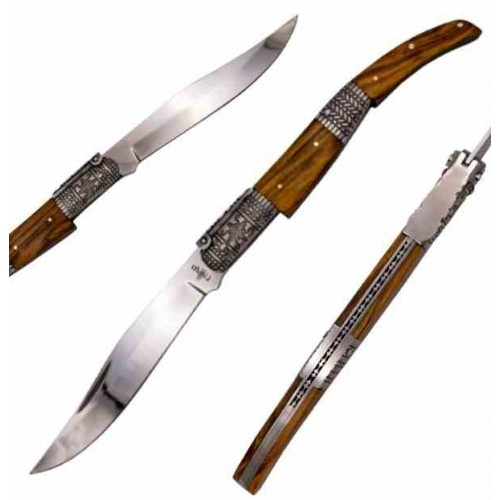The knife , an essential ancient tool
The knife is one of the oldest tools used by humanity: Its origin dates back to prehistoric times, when our ancestors carved sharp stones to cut meat, hides, and vegetables.
Over time, their design evolved, adopting materials such as bronze, iron, and later, steel, giving rise to countless versions adapted to specific uses: cooking, hunting, combat, crafting, survival, or military use. But they all share certain basic components that define their shape, ergonomics, and utility.
Understanding knife anatomy not only helps you choose the right model, but also improves its use, maintenance, and safety.

The parts of the knife
The sheet
It's the main part of the knife and is designed for cutting. It can be made of stainless steel, carbon steel, ceramic, or other materials. It comes in different shapes depending on the knife's use (fine point, curved, straight, serrated, etc.), and its design involves several sections that determine how it cuts, pierces, or penetrates:
- The tip . It's the sharpest end of the knife, and its design can vary depending on the intended use. A sharp point allows for efficient penetration, which is crucial in hunting or survival knives. Its shape can also influence the type of cut, from stabbing to curved.
- The edge . The sharp edge of the blade is what allows the knife to make precise cuts. There are multiple types of edges: plain, serrated, combination, or serrated. The choice of edge will depend on the material being cut and the intended use.
- The loin . The spine is located opposite the edge and acts as a structural support. Its thickness and shape (flat or angled) influence the blade's pressure capacity and durability. On some survival knives, the spine is designed to be struck or pressed securely, such as a crenellated spine . A knife with a double edge, on both sides of the blade, lacks this.
- The emptying . Depending on the groove, the knife can have more or less penetration in the cut; this section determines the type of cut performed. The groove is the way the blade is shaped from the spine to the edge. A concave groove provides more precise cuts, while a convex groove provides greater impact resistance.
The crenellated
Also known as jimping, it is a series of small grooves or notches usually located on the spine of the blade, near the handle , or in some cases, as part of the handle itself . Its function is to provide a non-slip support for the thumb or index finger during use, providing greater control, safety, and precision when cutting.
This element is very common in tactical, hunting, survival, or professional knives, where a firm grip and maneuverability are essential.
Although often overlooked, crenellation significantly improves the knife's ergonomics, especially for tasks requiring pressure or controlled cuts.

The spike
It 's the part of the blade that extends into the handle. Depending on its type, it influences the knife's strength and durability.
Although it is not the only way to classify it, in general terms it can be:
- Complete : runs along the entire handle, offering greater stability and durability, which is key in intensive use knives such as hunting or combat knives.
- Partial : It is shorter, and is usually seen in inexpensive or lightweight knives.
The grip or handle
This is the part where the knife is held. It not only provides grip, but also serves as protection, balance, and safety for the user.
Normally, it shouldn't exceed 12 cm in length, as this is a comfortable enough size for even a large hand. It should also be ergonomic, durable, and non-slip.
It can be made of wood, plastic, polymer, rubber, micarta or metal, and there are even some made of bone.
Its design determines the comfort, precision and safety when using the knife, and in turn, several parts can be identified:
- Knob . Located at the opposite end of the tip, it's decorative on some knives, but it serves a practical purpose as a counterweight to balance the knife. On tactical knives, it's known as a glass breaker or even a "bogeyman ," unofficially in some places, as it's designed for dry impacts on tactical and military models.
- Save . It's the part that separates the blade from the handle and serves as a guard to prevent the hand from slipping toward the edge. It's essential for combat or survival knives, where a firm grip can save lives.
- Muscles . The grips form the outer part of the handle, providing comfort, control, and aesthetic design. They are generally secured with screws or rivets.
- Screws . These metal elements, if present, secure the various parts of the handle. They are usually visible and easily accessible for maintenance or replacement of parts, especially on professional knives.

Although it may seem simple, a knife is a highly specialized tool with each component serving a specific purpose. From the blade to the handle, everything is designed for safety, performance, and durability.
Don't forget to check out our amazing knives , you might find the perfect one for you.









